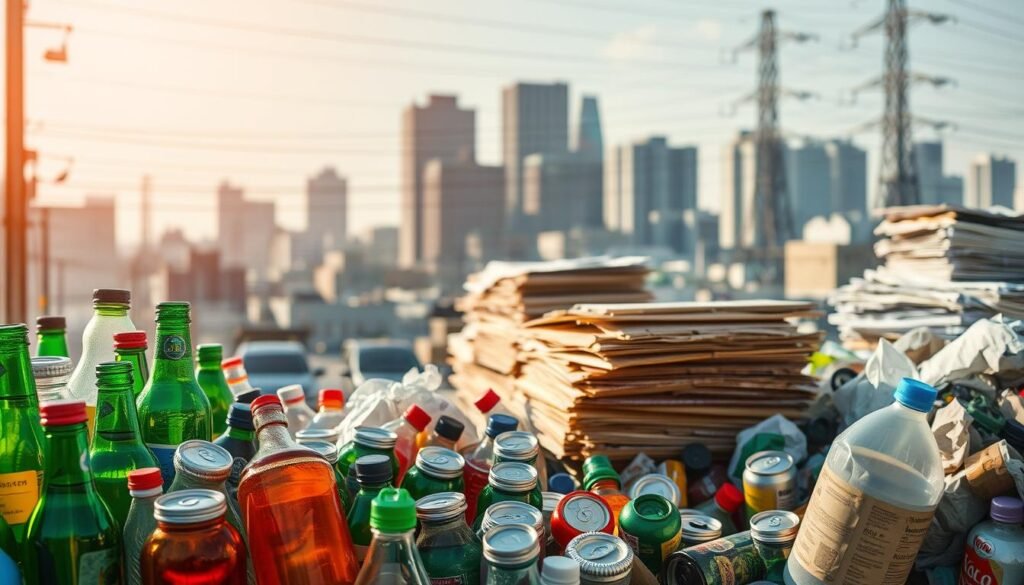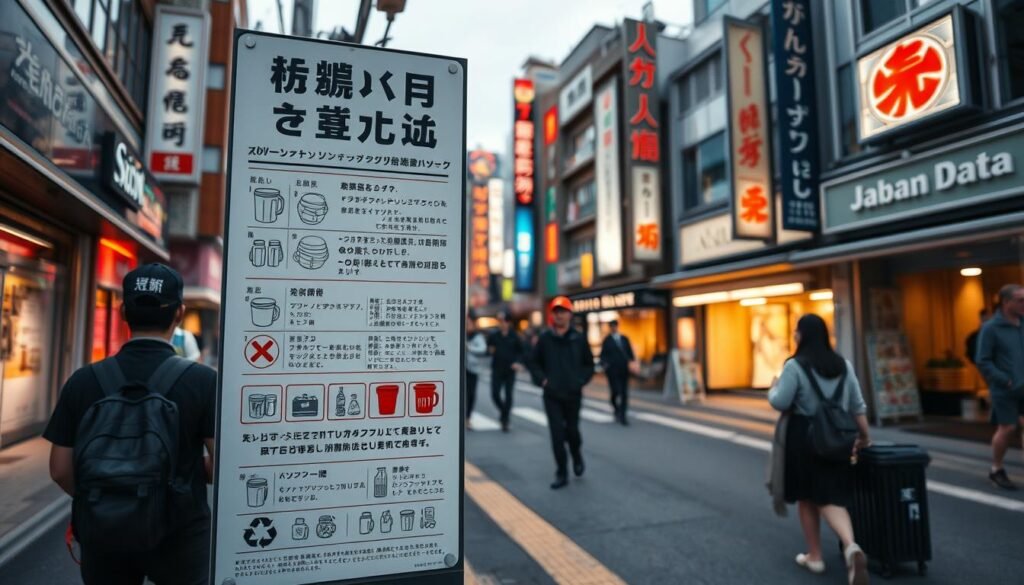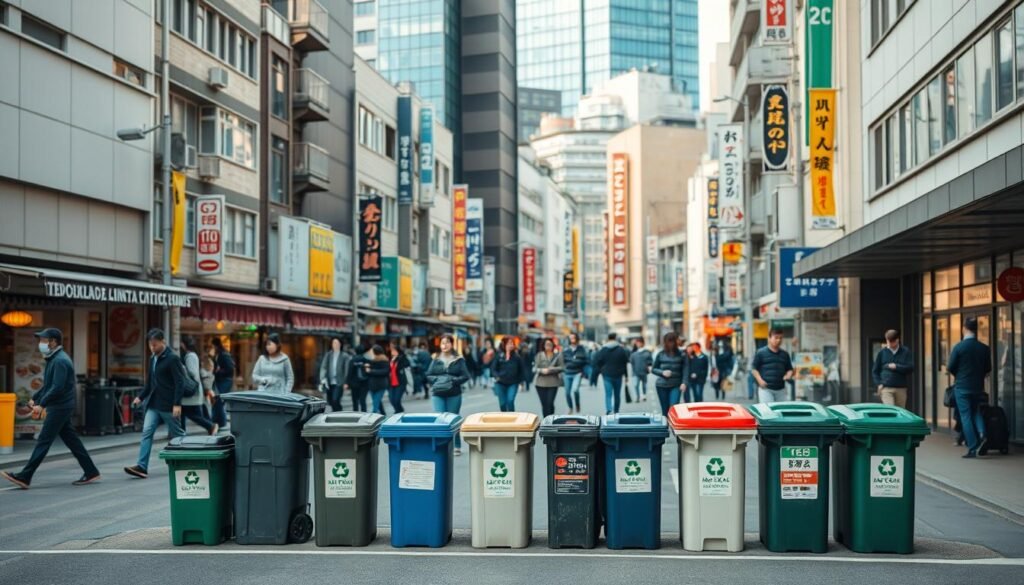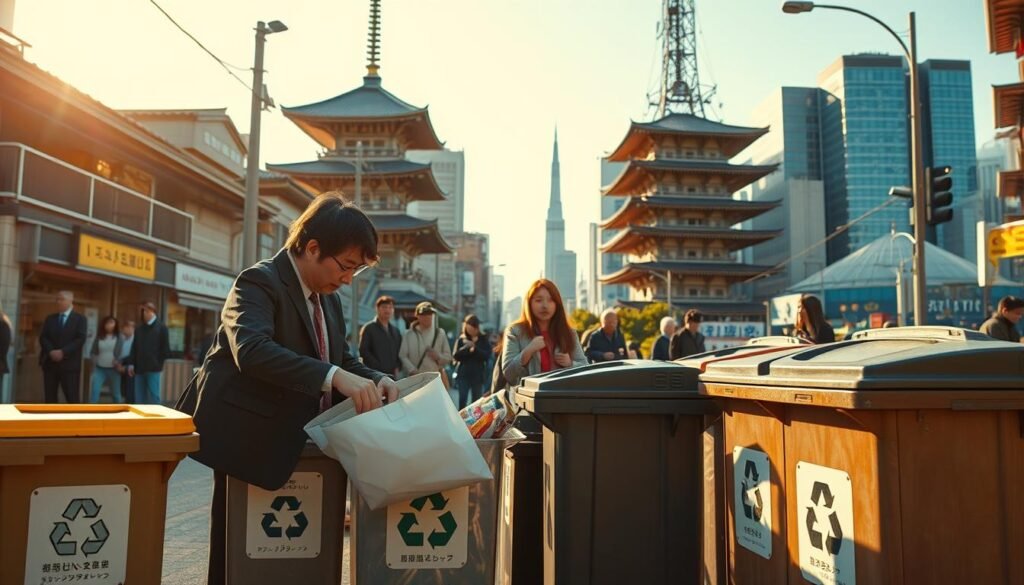Do you know how to handle trash and recycling in Japan? Well, Japan is renowned for its meticulous and innovative approach to waste management, a system rooted in the nation’s commitment to sustainability. For eco-conscious travelers, navigating the Japanese waste disposal system can initially seem daunting, but understanding the nuances of trash in Japan can be both enlightening and rewarding.
From the moment you arrive, you’ll notice the emphasis on sustainable waste management in Japan. With clear guidelines and color-coded bins, Japan has perfected the art of separating and disposing of waste. This traveler’s guide aims to demystify the process, providing practical tips to help you manage your trash and recycling responsibly during your stay.
Key Takeaways
- Japan’s waste management system is detailed and eco-friendly.
- Understanding trash in Japan involves learning about combustible, non-combustible, and recyclable waste.
- Proper waste separation is crucial for sustainable waste management in Japan.
- Tourists should adhere to local guidelines for Japanese waste disposal system.
- Learn the locations and use of color-coded recycling bins to manage waste effectively.
Introduction to Waste Management in Japan
Japan is renowned for its meticulous approach to waste management, an essential aspect of maintaining the country’s renowned cleanliness. The waste management in Japan is governed by stringent environmental regulations in Japan ensuring that cities remain spotless despite their high population densities.
The key to understanding this system lies in the Japanese trash sorting guidelines. Residents are required to separate their waste into various categories, such as combustible, non-combustible, and recyclable materials. This practice is embedded into daily life, making everyone a participant in environmental conservation.
“Mottainai” – a term deeply rooted in Japanese culture – encapsulates the ethos of reducing wastefulness and promoting respect for resources. This cultural philosophy further reinforces the effectiveness of Japan’s waste management system.
National legislation also plays a significant role in shaping the waste disposal landscape. The strict environmental regulations in Japan mandate that municipalities adhere to comprehensive guidelines aimed at managing and reducing waste effectively.
This synergistic approach, combining cultural values with robust legislative frameworks, ensures that waste management in Japan is not only efficient but also sustainable, setting a global benchmark in environmental stewardship.
Types of Trash and Recycling in Japan

Understanding the types of trash and recycling categories in Japan is crucial for adhering to local waste management practices. Visitors need to familiarize themselves with the classification system to ensure proper waste disposal in Japan.
Combustible Waste
Combustible waste includes items that can be burned, such as food scraps, paper, and certain types of plastics. These items should be disposed of in designated combustible waste bags, typically available at convenience stores and supermarkets. Proper handling of combustible waste helps in the reduction of landfill waste and contributes to energy recovery initiatives.
Non-Combustible Waste
Non-combustible waste comprises items that cannot be burned, such as metals, glass, and certain types of ceramics. This type of waste should be separated from other trash and placed in specific non-combustible bags. Accurate trash separation in Japan ensures that non-combustible materials are appropriately processed, minimizing environmental impact.
Recyclable Materials
Recyclable materials in Japan include PET bottles, glass bottles, cans, and paper. Each type of recyclable requires specific handling—such as rinsing out bottles and removing labels. Dedicated recycling bins are widely available in public spaces, making it convenient to contribute to the recycling efforts. Effective sorting of recyclable materials in Japan is vital for maintaining the country’s high recycling rates and sustainability goals.
How to Dispose Trash in Japan
Understanding how to dispose trash in Japan is crucial for maintaining the country’s strict waste management system. The process involves careful sorting and adherence to specific garbage disposal rules in Japan. Different types of waste are handled in unique ways, and failing to follow the guidelines can result in fines or penalties.
To start, familiarize yourself with the categories of waste as defined by municipal waste disposal Japan practices. Household waste is typically divided into three main types: combustible, non-combustible, and recyclable materials. Each category has its own unique disposal method.
Combustible waste, which includes kitchen scraps and used tissues, should be placed in designated bags provided by your local ward office. Non-combustible waste, like ceramics and metals, needs to be discarded separately and may have specific collection days. Recyclable items such as glass bottles, cans, and PET bottles require proper rinsing and sorting into appropriate bins.
| Type of Waste | Examples | Disposal Method |
|---|---|---|
| Combustible Waste | Kitchen scraps, tissues | Designated bags, collected on specific days |
| Non-Combustible Waste | Ceramics, metals | Separate collection days |
| Recyclable Materials | Glass bottles, cans, PET bottles | Rinse and sort into appropriate bins |
For tourists, it is essential to check local municipal waste disposal Japan guidelines as they can vary by region. Information is often available at hotels, tourist information centers, and local ward offices. By following these guidelines, you contribute to a cleaner and more environmentally friendly Japan.
Understanding Japan Garbage Rules for Tourists

When traveling to Japan, it’s crucial to understand their meticulous garbage disposal practices. These guidelines are not just for residents but also for tourists. Japan garbage disposal regulations require strict separation of waste, ensuring recyclable materials are adequately sorted.
First, familiarize yourself with the local garbage disposal schedule. Different types of waste, such as combustible, non-combustible, and recyclable, are collected on specific days. Missing these collection times can lead to inconvenient storage issues. Always ask your hotel or host about the local schedule to avoid any mishaps.
Emphasizing the importance of separating trash accurately, Japan garbage rules for tourists mandate categorizing waste into several distinct groups. Combustible waste generally includes items like food scraps and paper, while non-combustible waste encompasses ceramics and small metal items. Recyclables are sorted into subcategories such as plastics, glass bottles, and aluminum cans. Ensuring you dispose of waste correctly helps maintain Japan’s clean public spaces.
Additionally, when disposing of garbage in Japan, proper etiquette plays a significant role. Always clean recyclables before tossing them into the respective bins. This practice is not just courteous but also essential as per garbage disposal regulations Japan adheres to, facilitating proper recycling processes. Public trash bins can be scarce, particularly in residential areas, so carrying a small bag for your waste until you find an appropriate disposal point is a good practice.
Understanding these Japan garbage rules for tourists ensures you contribute positively to Japan’s renowned cleanliness. Observing these practices also respects the efforts of local communities in maintaining their environment. Travelers can enjoy a more immersive and considerate visit by adhering to these established guidelines.
Japan Recycling Guide: Essential Tips for Travelers

Understanding and following Japan’s recycling system can greatly enhance your travel experience and contribute to the country’s waste management efforts. Travelers must become familiar with identifying and utilizing designated recycling bins, the types of materials allowed, and local rules that govern disposal.
Recycling Bins and Locations
Japan has a comprehensive network of recycling bins strategically located in public areas such as train stations, convenience stores, and parks. Recognizing the bin types and their intended use is key to efficient waste separation.
- Plastic Bins: Often marked in blue, these bins are for PET bottles and other recyclable plastics.
- Cans and Glass Bins: These can be distinctively marked and are typically found next to plastic bins.
- Combustible Waste Bins: Generally marked in red, for items that cannot be recycled, like used tissue or food wrappers.
Recycling facilities in Japan ensure that these materials are processed correctly, making your contribution important even while traveling.
Local Recycling Rules
Each municipality in Japan has specific guidelines for recycling and waste separation that tourists should be aware of. It is crucial to respect these local rules to avoid penalties and support the community’s sustainability efforts.
In Tokyo, for instance, you are required to wash out plastic containers and remove labels before disposal. Similarly, Kyoto emphasizes the separation of organic and inorganic waste.
Here is a summarized comparison of local recycling rules in popular tourist areas:
| Location | Plastic Recycling | Glass Recycling | Combustible Waste |
|---|---|---|---|
| Tokyo | Wash and sort | Separate by color | Marked bags |
| Kyoto | Remove labels | Sort by type | Clear bags |
| Osaka | Crush bottles | Rinse and separate | Colored bags |
By following these guidelines, you contribute positively to waste separation japan tourists and support the efficiency of recycling facilities in japan. This Japan recycling guide outlines essential tips and locations to help travelers manage waste responsibly during their visit.
What to Do with Garbage in Japan: A Step-by-Step Guide
Navigating the intricate process of proper trash disposal in Japan can be daunting, especially for travelers. This step-by-step guide aims to demystify the process, ensuring you understand everything from sorting trash to the correct disposal methods. Understanding what to do with garbage in Japan is essential for respecting local customs and contributing to environmental sustainability.
Sorting Trash
Sorting trash in Japan is critical. The majority of municipalities adhere to a robust recycling and waste separation system. Below is a general breakdown of the sorting categories you might encounter:
- Combustible Waste: Includes kitchen scraps, paper, and other burnable items.
- Non-Combustible Waste: Items like metals, glass, and ceramics.
- Recyclable Materials: Separate plastics, PET bottles, cans, and paper products.
It’s crucial to follow these categories and use the designated bags provided by the local municipalities. This ensures proper trash disposal in Japan and avoids any potential fines.
Proper Disposal Methods
Once you’ve sorted your trash, understanding what to do with garbage in Japan involves knowing the disposal methods. Different municipalities may have unique rules, but the following steps are commonly observed:
- Combustible Waste Disposal: This trash is usually collected on specific days of the week. Make sure to place your properly bagged combustible waste at designated trash collection points before collection time.
- Non-Combustible Waste Disposal: This type of waste might only be collected once or twice a month. Keep an eye on the local collection schedule to ensure you don’t miss these dates.
- Recyclable Materials Disposal: Use clearly marked bins for recyclables, often found in public areas, convenience stores, and train stations. Sorting these materials correctly facilitates easier recycling and environmental conservation.
By adhering to these methods and understanding proper trash disposal in Japan, you contribute to a cleaner and more sustainable environment. Travelers should always check local guidelines to ensure compliance with specific disposal practices.
Trash and Recycling in Japan: Dos and Don’ts

When handling trash and recycling in Japan, there are some key dos and don’ts that can guide visitors toward responsible waste management. Japan is renowned for its stringent recycling practices, and understanding them is vital for respecting local customs and environmental efforts.
Do: Familiarize yourself with the local trash disposal schedule. Different areas may have different pick-up days for various types of waste, such as combustible, non-combustible, and recyclables.
Don’t: Mix different types of waste. It’s essential to adhere to the categorized system for trash and recycling in Japan to avoid fines and support sustainable waste solutions in Japan.
Do: Clean your recyclables before disposal. For instance, rinse out plastic bottles and food containers to prevent contamination and facilitate proper recycling.
Don’t: Dispose of oversized items without proper arrangements. Items like furniture or electronics require special handling. Check with the local waste management facility for specific guidelines.
Do: Engage in local environmental initiatives in Japan. Participate in community clean-up events or support businesses that prioritize eco-friendly practices.
Don’t: Throw away batteries or hazardous materials in regular trash. These items often have designated collection points to ensure they are disposed of safely and sustainably.
To make these dos and don’ts even clearer, here’s a helpful table summarizing the key points:
| Do | Don’t |
|---|---|
| Follow local trash schedules | Mix different types of waste |
| Clean recyclables before disposal | Dispose of oversized items indiscriminately |
| Engage in environmental initiatives in Japan | Throw hazardous materials in regular trash |
By following these simple dos and don’ts, travelers can contribute to sustainable waste solutions in Japan and support the country’s forward-thinking environmental initiatives.
Japan Travel Trash Tips for Tourists

Traveling through Japan can be a seamless experience if you understand the country’s strict waste disposal system. Adopting these Japan travel trash tips will ensure you’re responsible and respectful during your visit.
Common Mistakes to Avoid
Avoiding common pitfalls can significantly enhance your travel experience. Firstly, it’s crucial to recognize the categories for proper garbage disposal Japan employs. Don’t mix combustible and non-combustible items; this is a frequent error among tourists. Additionally, refrain from disposing of trash in public areas not designated for waste. Japan is meticulous about keeping public spaces clean, so follow local guidelines diligently.
Helpful Resources
To assist tourists, there are numerous resources available. Download apps like EcoBin or visit websites such as the Ministry of the Environment Japan for comprehensive guidelines. These tools are invaluable for responsible waste disposal Japan. Local contacts, such as hotel concierges or tourist information centers, can also provide tailored advice for proper garbage disposal Japan. By utilizing these resources, you can navigate the waste disposal system with greater ease and confidence.
Waste Separation Japan Tourists Should Know

Understanding the intricacies of waste separation in Japan is crucial for any visitor aiming to respect local customs. Japan has a diligent system in place that ensures effective waste management, making it essential for everyone, including tourists, to follow specific guidelines.
Color-Coded Sorting
Japan implements a color-coded system for waste separation to facilitate the recycling process. Entailing different categories such as combustibles, non-combustibles, and recyclables, this method aids in achieving efficient garbage collection in Japan. For instance, burnable waste is usually placed in red or orange bags, while non-burnable waste goes in blue bags. Recyclables such as plastics and glass have designated bins, often color-coded by type.
Municipal Guidelines
Municipal regulations further dictate the trash disposal guidelines in Japan. These guidelines can vary slightly from one city to another, but they generally encompass similar principles. It’s imperative that tourists refer to local instructions provided by their accommodation or municipal offices to ensure they are following the correct procedures. Incorrect disposal can result in fines or the trash not being collected. Thus, adhering to these rules not only shows respect for the local practices but also helps maintain cleanliness and environmental sustainability.
- Consult the local municipal guidelines for specific trash disposal methods.
- Use the correct color-coded bags for different types of waste.
- Follow the schedule for garbage collection in Japan as provided by local authorities.
Trash Collection System in Japan: Key Information

Understanding the intricate trash collection system in Japan can be quite enlightening for travelers. Japan is renowned for its meticulous waste management practices, ensuring its cities remain clean and organized.
A critical component of this system is the adherence to waste disposal regulations in Japan. Each municipality might have slight variations in their guidelines, but the core principles remain consistent across the country.
To manage trash collection in Japan, specific collection days are designated for different types of waste. For instance, combustible waste might be collected on Mondays and Thursdays, while non-combustible waste is picked up on Wednesdays.
Furthermore, some areas impose fees for the disposal of large items or certain types of recyclables. These fees cover the cost of specialized handling and recycling processes, ensuring the sustainability of the trash collection system in Japan.
Tourists are encouraged to familiarize themselves with the local collection schedule upon arriving at their destination. It’s not uncommon to find detailed brochures in English at local municipal offices or in tourist information centers, laying out the specifics of the waste disposal regulations in Japan.
Ultimately, being informed about the trash collection system in Japan allows travelers to contribute positively to Japan’s clean and orderly environment, ensuring they leave behind a minimal ecological footprint during their stay.
Sustainable Practices in Japan: Reducing Waste
Japan is renowned for its dedication to sustainability, which is reflected in the daily practices of its residents. Both locals and tourists can participate in eco-friendly waste disposal in Japan to contribute to preserving the environment. By adopting a few simple habits, everyone can help promote sustainable living in Japan.
Eco-Friendly Products
Japanese markets offer a wide variety of eco-friendly products designed to minimize waste. From biodegradable cleaning supplies to organic personal care items, these products help reduce the impact on the environment. Moreover, many stores encourage their customers to bring reusable shopping bags, a practice that aligns with sustainable living in Japan.
Reusable Items
Using reusable items is one of the most effective ways to practice sustainability. In Japan, reusable containers, water bottles, and lunch boxes are readily available. Carrying these items not only supports sustainable practices in Japan but also makes daily life more convenient and environmentally friendly.
“In Japan, sustainability is not just a trend but a way of life. Embracing eco-friendly waste disposal in Japan helps in maintaining this balance, ensuring a better future for all.”
Adopting these practices can make a significant difference in reducing waste and promoting a more sustainable lifestyle. Whether you’re in Japan for a short visit or a longer stay, these habits will help contribute to the country’s impressive sustainability efforts.
Advanced Tips for Handling Trash and Recycling in Japan
For seasoned travelers and expats, achieving excellence in waste management involves adopting advanced tips for handling trash and recycling in Japan. This goes beyond just knowing the basics—it’s about mastering the nuances of segregation of waste in Japan and perfecting Japanese recycling practices.
It’s essential to understand that Japanese recycling practices are deeply ingrained in the culture, leaving little room for error. One of the most advanced tips for handling trash and recycling in Japan is ensuring the absolute cleanliness of recyclables; items like plastic containers and bottles must be washed thoroughly to avoid contamination.
When dealing with segregation of waste in Japan, familiarity with local rules is crucial. Each municipality may have its specific regulations and designated days for collecting various types of waste. Keeping a schedule handy will help you stay aligned with these guidelines, ensuring that waste is disposed of correctly.
Another advanced tip in the realm of Japanese recycling practices is the meticulous sorting of household waste. For instance, items such as batteries, electronics, and light bulbs often have special disposal requirements. Identifying the correct drop-off locations for such items is key to preventing improper disposal and contributing to a more efficient recycling system.
| Waste Type | Collection Days | Additional Notes |
|---|---|---|
| Combustible Waste | Monday, Thursday | Non-recyclable kitchen waste, small wooden items |
| Non-Combustible Waste | Wednesday | Metal items, glass, ceramics |
| Recyclable Materials | Tuesday, Friday | Separate by type: PET bottles, paper, plastics |
Lastly, utilizing community resources such as local waste management websites and brochures can provide updated, area-specific information that enhances your waste disposal efforts. Staying informed and engaged with community practices not only facilitates proper waste management but also highlights your commitment to sustaining the environment during your stay in Japan.
Conclusion
Understanding Japan’s waste management system is essential for any traveler wanting to enjoy a truly enriching experience. By adhering to the country’s meticulous trash disposal rules, you contribute not only to maintaining its pristine environment but also to its cultural integrity. Adoption of environmentally friendly practices in Japan ensures that you leave a positive impact on the places you visit.
Embracing eco-friendly disposal in Japan demonstrates respect for local customs. Sorting and disposing of waste responsibly means more than just following rules—it’s a part of sustainable living Japan encourages among both residents and visitors. Being a conscientious traveler involves integrating these practices into your daily routine, thereby playing a vital role in preserving Japan’s natural beauty.
In conclusion, your efforts in handling waste appropriately—whether by following color-coded sorting, respecting municipal guidelines, or utilizing reusable items—showcase a commitment to eco-friendly disposal in Japan. Such actions contribute significantly to the nation’s broader goals of sustainability and environmental stewardship. Through these conscientious practices, you help ensure that Japan remains a clean, beautiful, and welcoming destination for future generations of travelers.






